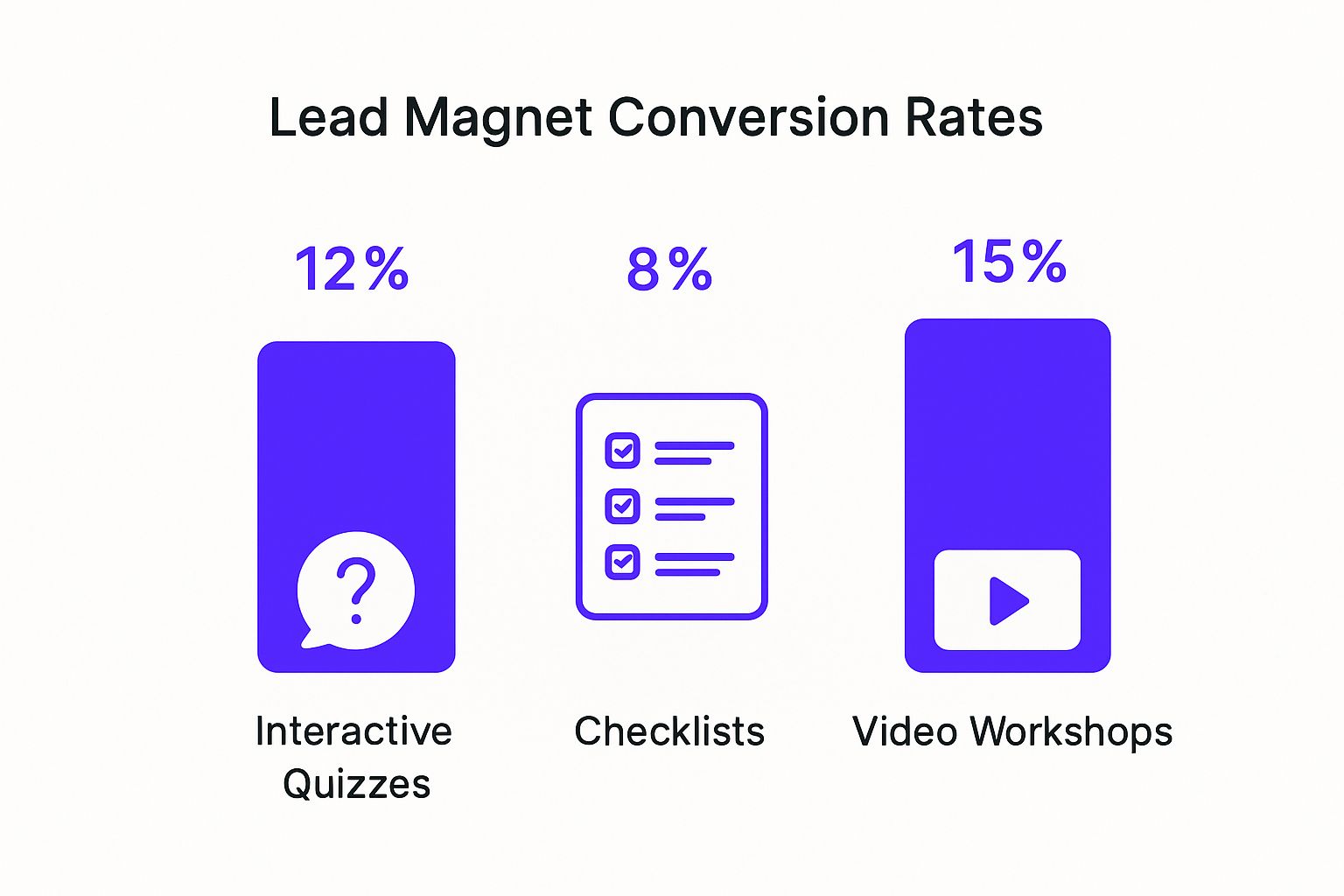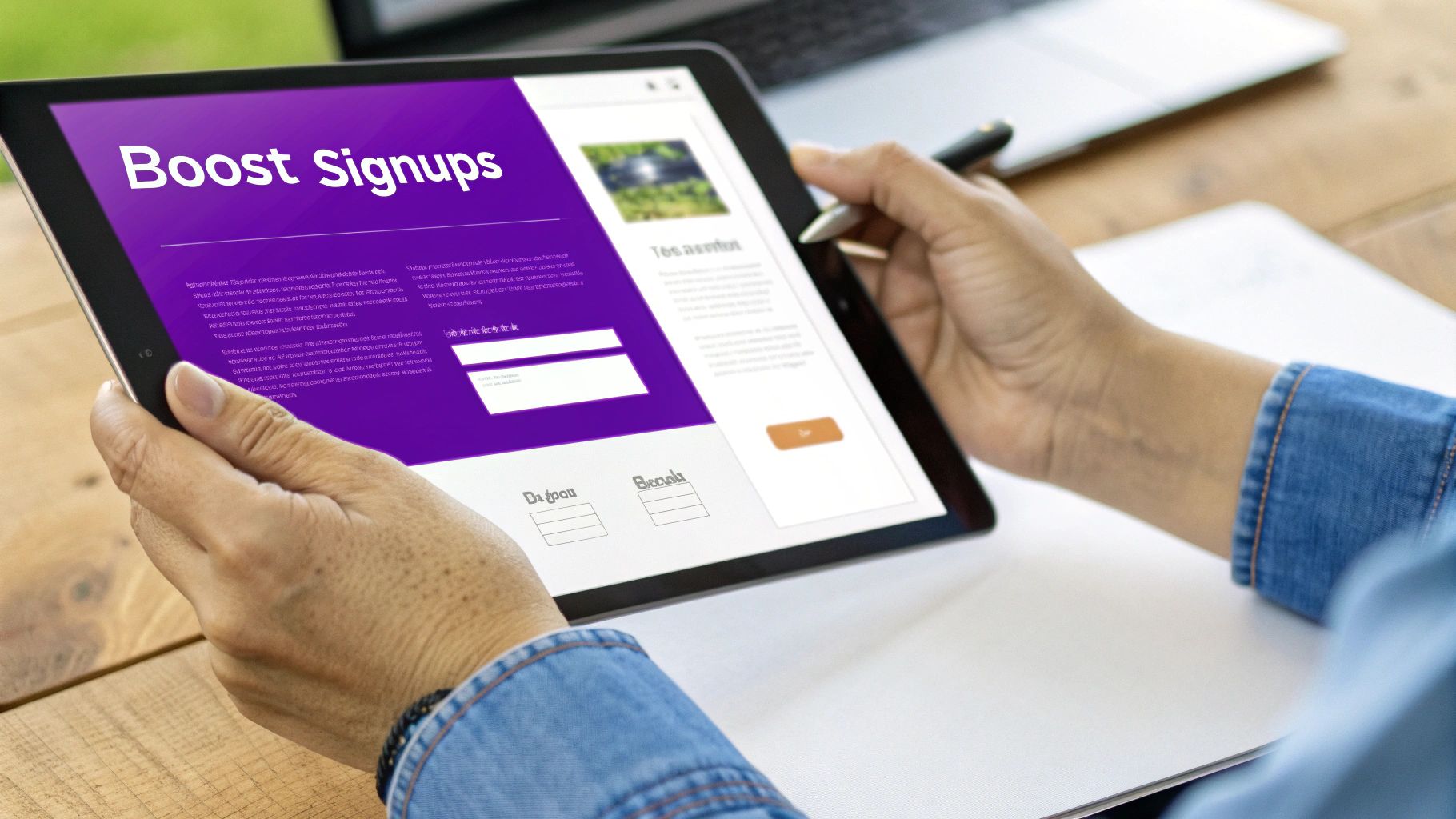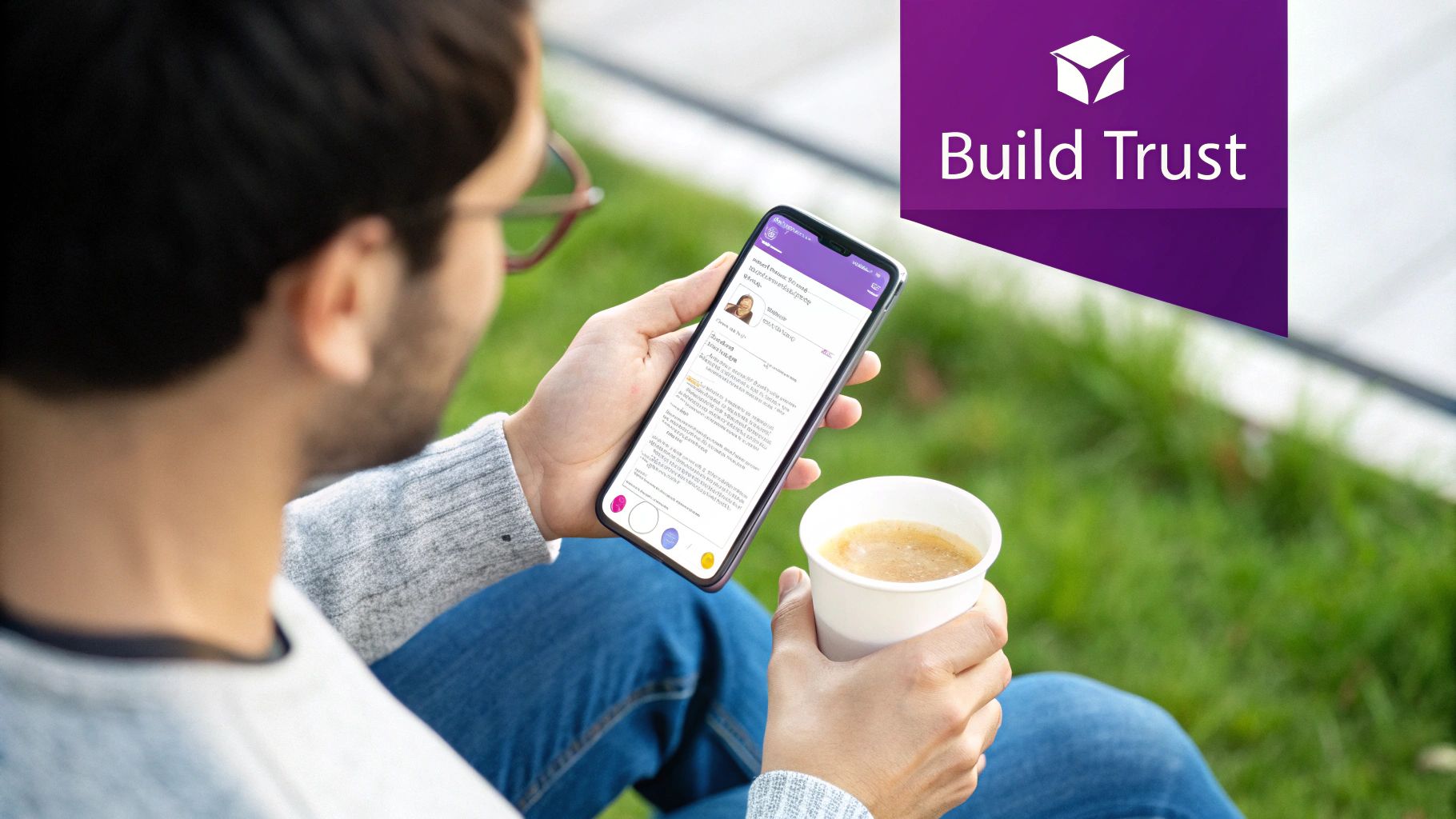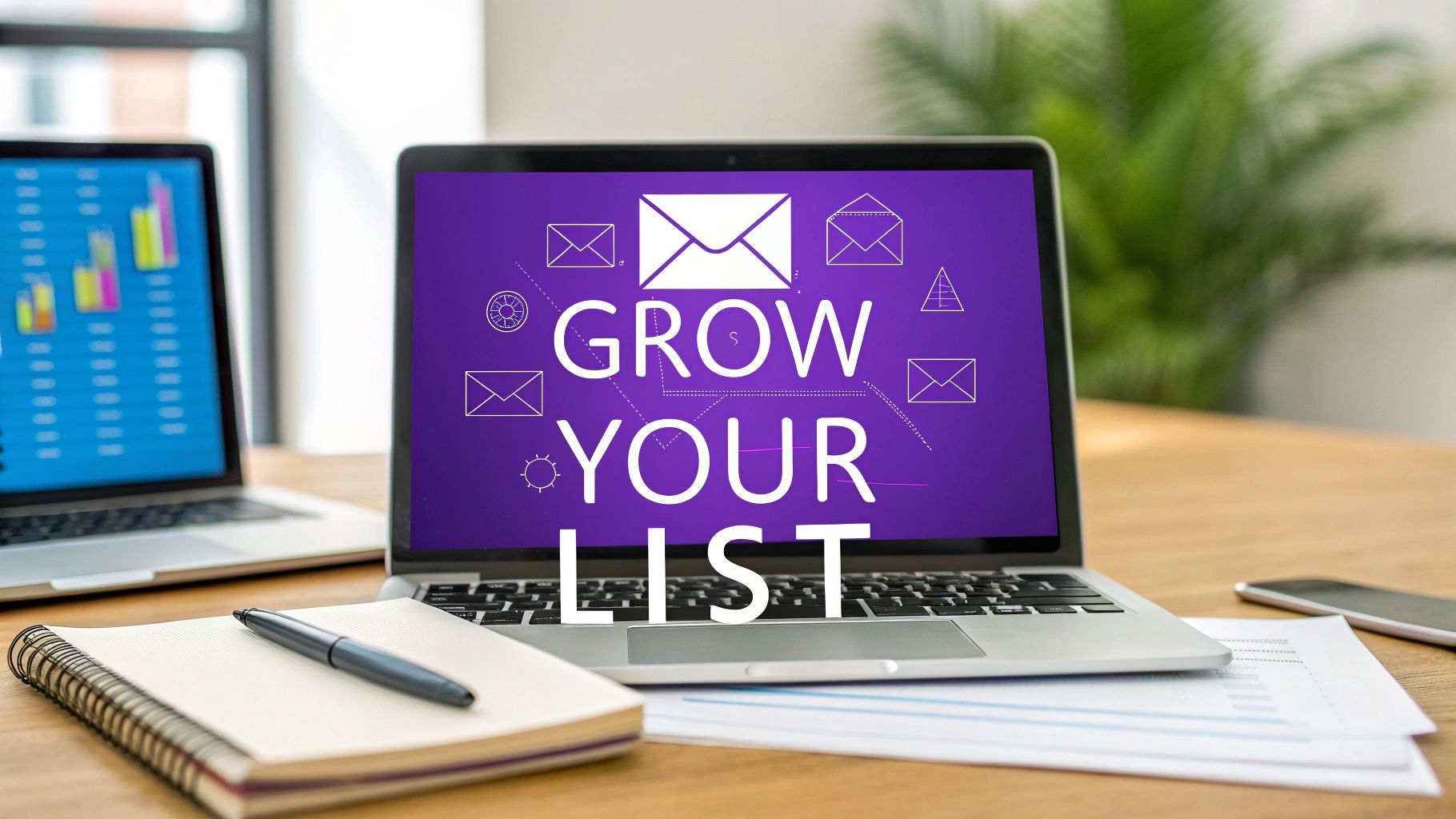How to Build Email Lists That Actually Grow Your Business
Forget renting an audience from social media—building an email list is about owning that relationship. It’s a direct line to your people, built by offering them something genuinely valuable in exchange for their trust (and their email address). This whole game is played with killer lead magnets, smart opt-in forms, and a solid email service provider.
Why an Email List Is Your Best Marketing Investment

Let’s be blunt. Social media algorithms are fickle, and ad costs are a rollercoaster. Your email list? That's a tangible asset, a reliable connection to your audience that drives predictable revenue and builds real loyalty.
Stop thinking of it as just collecting contacts. You're building a community of your biggest fans—people who actually want to hear from you. This direct channel is your safe harbor, completely immune to the whims of algorithms, ensuring your message always lands. For a closer look at getting those first names on your list, our guide on https://rebusadvertising.com/blogs/how-to-generate-leads-online/ is the perfect starting point.
The Power of Direct Communication
Unlike a social feed where your reach can get slashed overnight, email is stable and refreshingly personal. Every single subscriber has given you explicit permission to show up in their inbox, which makes them an incredibly warm audience. That direct line builds trust and lets you send personalized messages that actually resonate.
Here’s why it’s a no-brainer:
- You Own It: Your list is yours. No platform can change its rules and take it away from you. It’s your turf.
- Sky-High Engagement: These people already like you. That means they’re far more likely to open your emails and click your links than a random scroller on social media.
- Predictable ROI: Email marketing consistently crushes it on returns. The industry standard is an eye-watering $40 back for every dollar you put in.
An email list is the only marketing channel you truly own. It’s a direct pipeline to your most loyal followers, giving you the power to nurture relationships and drive sales without relying on unpredictable algorithms.
Understanding the Scale and Opportunity
The sheer number of people using email tells you everything you need to know. In 2025, we're looking at around 4.6 billion global email users. That number is set to climb past 4.8 billion by 2027.
Think about that. Nearly 60% of the entire world uses email, creating a massive pool of potential subscribers. Sure, the inbox is a competitive space, but a smart strategy makes your messages the ones people actually look forward to opening. For a full playbook on how to build an email list, you can find some fantastic insights from experts who live and breathe this stuff.
Create Lead Magnets People Genuinely Want
Let's get one thing straight: people don’t just hand over their email addresses for fun. You have to earn it. The modern inbox is a fortress, and to get past the gate, you need a seriously compelling offer. That's where your lead magnet comes in.
A killer lead magnet isn't a bribe; it's a handshake. It solves a specific, nagging problem for your ideal customer and delivers a quick win. It’s the first taste of the value you provide, proving your expertise and making them want to hear from you again.
Forget the dusty, 50-page ebook that no one has time to read. We're talking about high-impact, easily digestible resources that make subscribing feel like a no-brainer.
Pinpointing Your Audience's Pain
The best lead magnets start with empathy. You have to climb inside your audience's head to understand what’s keeping them up at night. What’s the one roadblock that’s driving them nuts?
Not sure where to start? Your own data is a goldmine.
- Top-Performing Blog Posts: Look at your analytics. Which articles get the most traffic, comments, and shares? That’s a giant blinking sign pointing directly at what your audience craves.
- Frequently Asked Questions: Sift through your support tickets, social media DMs, and sales call notes. If people are asking the same questions over and over, you’ve found your pain point.
- Customer Surveys: Just ask! A simple one-question poll on your site or social media can deliver incredible clarity. "What's the #1 thing you're struggling with when it comes to [your topic]?"
Once you’ve zeroed in on a core problem, your lead magnet needs to be the direct, actionable solution. If you’re a B2B software company and your audience is drowning in chaotic projects, a "Project Kickoff Checklist" is infinitely more valuable than a generic "Guide to Productivity."
This infographic shows just how much the format of your lead magnet can impact its performance.

As you can see, interactive and high-value formats like video workshops consistently crush it, pulling in far more sign-ups than static, low-effort options.
Crafting the Perfect Offer
Now that you know the problem you’re solving, it's time to build the solution. The magic formula is specificity + instant gratification. Your lead magnet should promise one clear outcome and deliver it fast.
The best lead magnets feel like a shortcut. They save the user time, money, or frustration by packaging a solution into a simple, accessible format. It's not about the quantity of information; it's about the quality and immediacy of the result.
Here are a few high-performing formats that work like a charm across different industries:
- Checklists: These are amazing for breaking down a complex process into simple, doable steps. A B2C skincare brand could offer a "Daily Glow-Up Skincare Routine Checklist."
- Interactive Quizzes: People love quizzes. They're engaging, fun, and can segment your audience automatically. A financial advisor could create a "What's Your Money Personality?" quiz that delivers personalized tips.
- Resource Hubs or Toolkits: Become the go-to expert by curating the best tools and templates on a topic. A marketing agency could offer a "Content Creator's Toolkit" with their favorite software and pre-built templates.
- Exclusive Video Workshops: A short, focused training session has a much higher perceived value than a simple PDF. A web design firm could offer a 15-minute workshop on "5 Simple Tweaks to Double Your Homepage Conversion."
Choosing the right type of lead magnet often depends on your business model. What works for an e-commerce store might not be the best fit for a B2B service provider.
Here’s a quick breakdown to help you match the perfect offer to your business.
Lead Magnet Ideas for Different Business Models
| B2C (Direct to Consumer) | Interactive Quiz | "Find Your Perfect Skincare Routine" Quiz | Highly engaging, provides personalized recommendations, and segments users based on their needs. |
|---|---|---|---|
| B2B (Business to Business) | Case Study or Whitepaper | "How We Increased a Client's Leads by 300% in 90 Days" | Builds authority, demonstrates expertise, and attracts qualified leads who are researching solutions. |
| E-commerce | Discount Code or Free Shipping | "Get 15% Off Your First Order" | Simple, direct incentive that drives immediate sales and captures emails from purchase-ready visitors. |
| SaaS (Software as a Service) | Free Trial or Demo | "Start Your 14-Day Free Trial" | The ultimate "try before you buy" offer. It lowers the barrier to entry and lets the product sell itself. |
| Coaching/Consulting | Exclusive Workshop or Webinar | "Free Masterclass: 5 Steps to Land Your Next Client" | Positions you as an expert, builds a relationship, and delivers immense value upfront, making a sale much easier. |
This table should give you a solid starting point, but don't be afraid to get creative and test what resonates with your specific audience.
Let's look at a real-world scenario. An e-commerce brand selling home organization products noticed their blog posts about "decluttering small spaces" were getting huge traffic. Instead of a generic ebook, they created a lead magnet called the "1-Hour Closet Cleanout Challenge," a beautifully designed, printable PDF.
The offer was specific, actionable, and promised a quick, satisfying win. The result? Their sign-up rate on those blog posts shot up from a measly 2% to over 10% almost overnight. That’s the power of solving a real problem.
Design Opt-In Forms That Actually Convert Visitors

Your lead magnet is the irresistible offer; your opt-in form is the gatekeeper. You can have the best freebie in the world, but a clunky, confusing, or uninspired form will stop your list growth dead in its tracks. This is where a casual browser’s interest becomes a real connection.
Think of your form as a micro-sales page. It has one job: convince someone that what’s on the other side is worth the tiny effort of typing in an email. Every single element—from the headline down to the button color—plays a part in that split-second decision.
The Anatomy of a High-Converting Form
A form that works is built with intention. It’s all about clarity, persuasion, and making the user's experience completely frictionless. It respects their time by getting straight to the point. Let’s break down what separates a form that gets ignored from one that builds your list on autopilot.
A killer form has a few key elements working together:
- A Magnetic Headline: This is no place for “Subscribe to Our Newsletter.” Your headline has to grab attention and scream value. Instead of “Join Our List,” try something like, “Get 10 Free Canva Templates to Triple Your Engagement.” See the difference?
- Benefit-Focused Copy: Keep it short and sweet. Use a sentence or a few bullet points to answer the only question that matters: what’s in it for them? Focus on the outcome they'll get.
- Frictionless Form Fields: Only ask for what you absolutely need. For most lead magnets, an email address is plenty. Every extra field you add, like a first name, can slash your conversion rate by up to 50%. Don't get greedy.
- A Powerful Call-to-Action (CTA) Button: The text on your button should be active and specific. “Download Now” is so much more compelling than the soul-crushing word, “Submit.”
The golden rule? Keep it simple. Strip away every non-essential element. Your goal is to create the fastest, clearest path from seeing the offer to clicking that button. Anything that causes a moment of hesitation is a conversion killer.
The example above from the pros at OptinMonster—a tool built specifically for this stuff—nails it. The design is clean and benefit-driven. The headline asks a direct question, the copy explains the value, and the fields are minimal, leading to a CTA that feels like the obvious next step.
Strategic Placement for Maximum Impact
Where you put your forms is just as important as how they look. You can't just slap them everywhere and hope for the best. Blasting visitors with a pop-up the second they land on your site is a great way to make them hate you. Instead, you have to think strategically about where they are in their journey.
Common Form Types and Where to Use Them
Exit-Intent Pop-Ups: These are the ninjas of the opt-in world. They only appear when a user’s cursor moves toward the “close” or “back” button. They’re way less intrusive and act as a final, last-ditch effort to capture their attention with a juicy offer, like a discount or an exclusive guide.
Inline (or Embedded) Forms: Placed right inside your blog content or at the end of an article, these forms are hyper-contextual. If someone just read a 2,000-word post from you, they are primed and ready for a related lead magnet. It just makes sense.
Slide-In Forms: These little guys slide into the corner of the screen after a user has scrolled a certain percentage down the page. They’re noticeable without being obnoxious, which makes them a fantastic middle-ground option.
Header or Footer Bars: Sometimes called "hello bars," these static banners at the top or bottom of your site give you a persistent, site-wide chance to get a signup without interrupting the experience. They're perfect for general offers like your main newsletter.
A/B Testing Your Way to More Subscribers
Never, ever assume your first design is your best one. The only way to know for sure what works is to test it. A/B testing, or split testing, is where you create two versions of your form and show each to a different slice of your audience to see which one performs better.
You’d be shocked at how tiny changes can lead to huge lifts in your subscription rate.
Actionable A/B Testing Ideas to Try Now:
- Button Color: Pit a high-contrast color (like bright orange or green) against a more subtle, on-brand color.
- Headline Copy: Test a question ("Want More Leads?") against a direct command ("Get More Leads Now").
- Number of Fields: See what happens when you ask for just an email versus a name and email. The results might surprise you.
- Image vs. No Image: Does a visual of your lead magnet actually help? Test it and find out.
- CTA Text: Compare a generic CTA like “Sign Up” with a benefit-oriented one like “Send Me the Cheatsheet!”
By constantly testing these elements, you’ll gather priceless data on what truly resonates with your audience. This is how you stop guessing and start building your email list predictably and effectively.
Set Up Your Foundational Tech Stack
Your lead magnets and opt-in forms are the engine and chassis, but let's be real—without a solid tech stack, you've just got a fancy car with no fuel system. Getting the right tools in place can feel like a huge, intimidating commitment, but it’s simpler than it looks.
At its core, all you need is a reliable way to collect emails, keep them organized, and actually send your messages.
This all starts with one key decision: picking an Email Service Provider (ESP). This is mission control for your entire email marketing operation. It’s where your subscribers live, where you’ll build your emails, and where you’ll geek out over your results.
Choosing the Right Email Service Provider
The ESP market is ridiculously crowded, but for most small and medium-sized businesses, the choice usually boils down to a handful of key players known for being user-friendly and packing some serious automation power.
Don't get stuck in analysis paralysis. The "best" ESP is simply the one that fits what you need right now and can grow with you down the road.
- For Beginners and Creators (ConvertKit): If you're a blogger, course creator, or coach, ConvertKit was practically built for you. Its real strength is in its dead-simple interface and powerful tagging system, which makes it incredibly easy to segment subscribers based on what they click and buy.
- For Advanced Automation (ActiveCampaign): If you need sophisticated "if this, then that" logic, ActiveCampaign is an absolute powerhouse. It has a visual automation builder that lets you map out incredibly detailed customer journeys, which is perfect for e-commerce or SaaS businesses.
The most important feature isn't the number of bells and whistles; it's the one you'll actually use. Pick a platform with an interface that feels intuitive to you. A simple tool you use consistently will always beat a complex one that gathers digital dust.
Honestly, most top-tier ESPs offer similar core features. The best move? Start a free trial, poke around the dashboard for an afternoon, and see which one just clicks. You can always migrate later if your needs change dramatically.
Your First Steps Inside Your ESP
Once you've picked your platform, it’s time to get your hands dirty. The initial setup is straightforward, but it’s absolutely crucial for creating a smooth workflow from the second someone signs up. This is where you lay the groundwork.
Your first two tasks are non-negotiable:
Create Your First "List" or "Audience": Think of this as the digital container where all your new subscribers will land. Give it a clear name you won't forget, like "Main Newsletter List" or "Blog Subscribers."
Set Up Your Welcome Automation: This is, without a doubt, the most important email you will ever send. An automated welcome email does way more than just deliver your lead magnet; it confirms the subscription, sets expectations for what's to come, and starts building that all-important relationship immediately.
This initial automation is your chance to make a stellar first impression. Keep it simple. The first email should deliver the promised goodie instantly. A follow-up a day or two later can share a bit about your brand's story or point them to some of your best content.
Getting this right ensures every new subscriber has a consistent, positive experience with your brand from the jump. And if you want to supplement your organic growth, integrating a reliable email finder tool can help you efficiently gather contact info to populate your list.
With this foundational tech in place, you can confidently start collecting emails, knowing the backend is ready to welcome every new subscriber with a professional, automated touch.
Nurture New Subscribers for Long-Term Trust
Getting an email address isn't the finish line; it's the starting pistol. The moment someone subscribes is your single best opportunity to make a lasting impression. How you handle these first few interactions determines whether you build a loyal fan or just another number on a spreadsheet.

The relationship kicks off with a powerful welcome sequence. This automated series of emails does way more than just deliver your lead magnet. It's your chance to roll out the red carpet, introduce your brand's personality, and set clear expectations for the value you're about to provide.
A strong welcome email is opened far more often than any other marketing message you'll ever send. Don't waste it. This is your prime moment to build trust and show new subscribers they made the right choice.
Crafting a Killer Welcome Sequence
Your welcome sequence is an automated onboarding process that makes every new subscriber feel seen. Think of it as a guided tour, not a content dump. The goal is to build momentum and reinforce the value you promised from the get-go.
A simple yet brutally effective welcome series might look like this:
The Instant Delivery: This email should land in their inbox within minutes of signup. It has one job—deliver the lead magnet. Keep it clean, simple, and laser-focused on getting them their promised goodie.
The Personal Introduction: Sent a day later, this email tells your story. Who are you? Why do you do what you do? This humanizes your brand and forges a genuine connection right away.
The Value Bomb: On day three, send them your absolute best, most helpful piece of content. This could be a link to your most popular blog post, a game-changing tip, or a useful video. You're proving your emails are worth opening.
The Soft Pitch: Finally, you can introduce a relevant product or service. By now, you’ve delivered so much value that this feels like a helpful suggestion, not a pushy sales pitch.
Your welcome sequence is your most powerful tool for turning a casual subscriber into an engaged follower. It’s where you prove your worth, set the tone for your relationship, and demonstrate that your emails are a source of value, not just noise.
This initial automation is a cornerstone of building a healthy list. Mastering the flow is essential, and understanding marketing automation best practices can give you a huge advantage in creating sequences that actually convert.
The Power of Smart Segmentation
As your list grows, treating everyone the same becomes a huge mistake. A one-size-fits-all message resonates with absolutely no one. This is where segmentation—dividing your list into smaller, more targeted groups—becomes your secret weapon.
Segmentation allows you to send the right message to the right person at the right time. The results are undeniable. According to a recent marketing report, segmented email campaigns can produce 30% higher open rates and 50% increased click-through rates compared to generic blasts.
You can segment your audience based on a ton of different data points.
Common Ways to Segment Your Email List
- Initial Interest: What lead magnet did they download? Someone who grabbed your "Social Media Checklist" is interested in totally different content than someone who downloaded your "SEO Guide."
- Behavioral Triggers: Have they clicked a link about a specific service? Did they visit your pricing page? These actions are screaming signals of their intent.
- Purchase History: Separating first-time buyers from repeat customers lets you send tailored thank-you notes, upsells, or loyalty offers.
- Engagement Level: Create segments for your most engaged fans (who open every email) and for subscribers who have gone quiet. This lets you reward your loyalists and create re-engagement campaigns for those who are slipping away.
Ultimately, smart segmentation is how you build an email list that feels personal and relevant. It transforms your list from a simple broadcast tool into a sophisticated communication engine, ensuring every email you send lands with maximum impact and strengthens your relationship with your audience.
Keep Your Email List Healthy and Compliant
So you've built a killer email list. High five! But here's the part nobody talks about enough: building it is just the start. Keeping that list clean, engaged, and legally sound is what separates the pros from the spammers.
Think of it like digital gardening. You can’t just plant seeds and walk away. You have to pull the weeds—the dead emails, the ghosts who never open anything—so the good stuff has room to grow. This isn't just a "nice-to-have"; it's the core of making email marketing actually work long-term.
The Unsexy but Crucial Art of List Hygiene
Over time, lists get stale. It’s natural. People switch jobs, abandon that old Hotmail account, or just lose interest. If you ignore this decay, your deliverability will tank. Sending emails to a bunch of dead addresses is a massive red flag for providers like Gmail and Outlook, and they'll start sending you straight to the spam folder.
To stay in their good graces, you have to embrace the cleanup.
- Kill the Bounces: If an email hard bounces (meaning it’s a permanent failure), delete it. Immediately. No second chances.
- Prune the Ghosts: Has someone not opened a single email from you in 90 days? They’re inactive. You can try a last-ditch re-engagement campaign, but if they still don’t bite, it’s time to say goodbye. It hurts, but it helps.
- Use a Verification Service: Got a huge list? Don’t try to clean it by hand. Tools like NeverBounce or ZeroBounce can scrub your contacts and flag the duds before you even hit send.
A clean list isn't about bragging rights over how many subscribers you have. It's about having the right subscribers. A smaller, super-engaged list will run circles around a massive, dead one every single time.
This kind of proactive maintenance is a game-changer. For a deeper playbook on this, check out our complete guide to email list management strategies.
Don't Mess with Privacy and Compliance
This part is non-negotiable. With privacy laws like GDPR in Europe setting the global standard, you can't afford to be sloppy with people's data. The fines are no joke.
But don't let the legal jargon scare you. The principles are actually just good, ethical marketing.
The whole game in 2025 is about building a clean, engaged list, not just hoarding emails. Stricter data privacy laws mean you have to get explicit, crystal-clear consent. Think of it as the modern, transparent way to build relationships. A clean list—free of inactive users, bad emails, and spam traps—doesn't just protect you legally; it boosts your sender reputation and makes sure your messages actually land. Want to go deeper? Ozrit.com has great insights on how clean data drives real engagement.
Here’s what you absolutely must do:
- Get Explicit Consent: Never, ever add someone to your list without their clear permission. Those sneaky pre-checked boxes? They're dead. Users have to actively opt-in.
- Be Totally Transparent: Tell people exactly what you'll be sending them and how often. No surprises.
- Make Unsubscribing Painless: Every single email needs a dead-simple, one-click unsubscribe link. Hiding it in tiny, gray font at the bottom isn't just shady—it's illegal in most places.
Got Questions About Building Your Email List? You're Not Alone.
Once you start collecting emails, the questions start rolling in. It's totally normal. Suddenly, you're wondering about frequency, what metrics actually matter, and what to do when people just stop opening your stuff. Getting these details right is what separates a list that just sits there from one that becomes your #1 marketing asset.
A classic first question is, "How often should I even be sending emails?" Look, there's no magic number here. A good rule of thumb to start with is once a week. It keeps you on their radar without becoming inbox wallpaper.
But the real answer? It depends. An e-commerce brand with a flash sale might blast out emails daily for a couple of days. A consultant sharing deep insights might stick to a thoughtful bi-weekly send. The key is to match your rhythm to the value you're providing.
Look Past the Open Rate—It’s a Vanity Metric
It's so easy to get obsessed with open rates, but honestly, they don't tell you much anymore. Thanks to privacy updates, that number can be wildly inaccurate.
The metric you should be watching like a hawk is your click-through rate (CTR). This number is gold. It tells you who's not just opening but actually doing something. A healthy CTR means your content is hitting the mark and your subscribers are engaged.
You also need to keep an eye on your unsubscribe rate. If you see a sudden jump, it’s a big red flag that something's off—maybe your frequency is too high, or your content isn't what they signed up for. You want to keep this number as low as humanly possible, ideally under 0.5%.
Your goal isn't just to show up in an inbox. It's to get people to act. Focus on metrics that prove your subscribers are paying attention, because that’s the true measure of a healthy list.
So, what about those subscribers who've gone radio silent? Don't just let them gather dust. This is the perfect time to run a re-engagement campaign. It's a short, automated series of emails designed to wake them up—maybe with a special offer, a question, or a simple "Hey, are you still interested?"
If they still don't bite after a few tries? It's time to let them go. A smaller list of people who are genuinely excited to hear from you will always, always be more valuable than a massive list of people who couldn't care less.
Ready to turn these strategies into real growth? The expert team at Rebus can help you build and manage an email list that drives results. Discover our full suite of marketing services and start your journey with us today!
